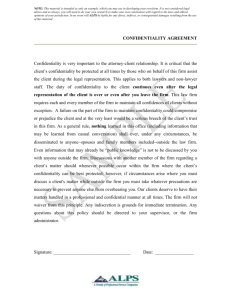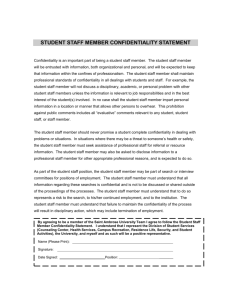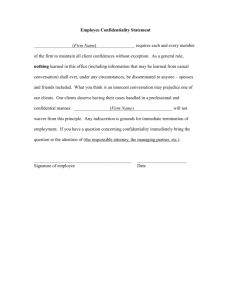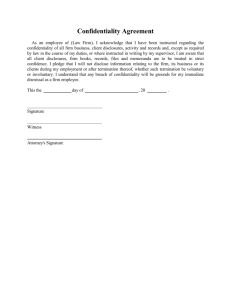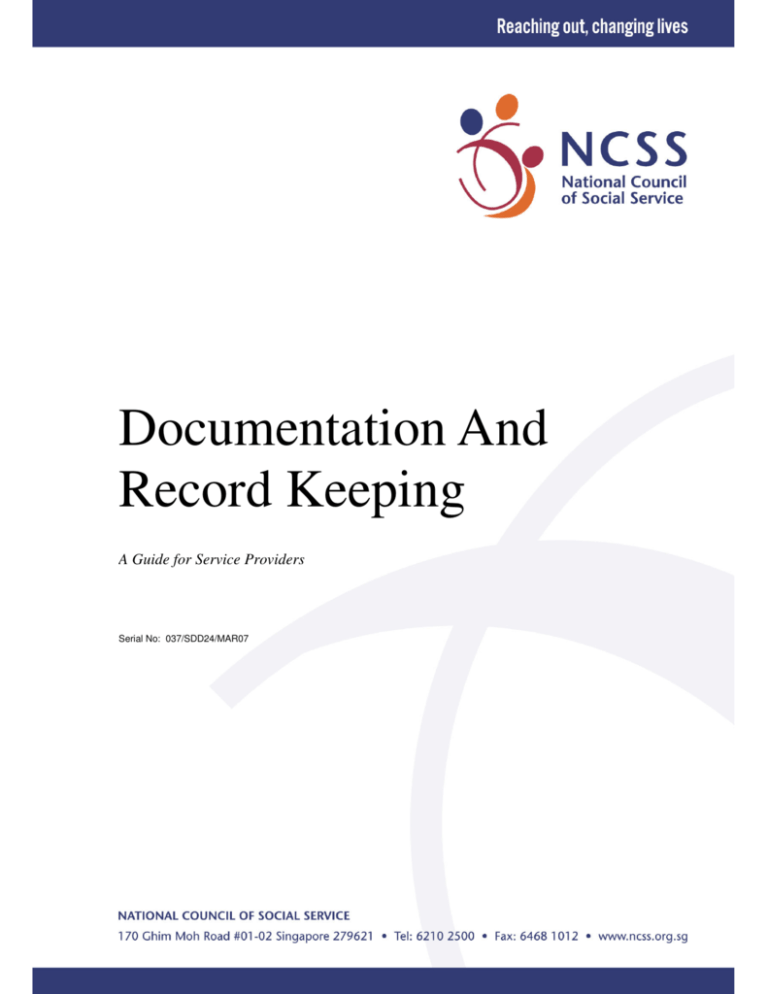
Documentation And
Record Keeping
A Guide for Service Providers
Serial No: 037/SDD24/MAR07
0
Contents
Page
Feedback
2
Foreword
3
Chapters
1
The Importance Of Documentation And Record Keeping
5
2
Guidelines for Documentation
7
3
Best Practices For Documentation
9
4
Guiding Principles For Record Keeping
11
5
Reviews of Records For Service Improvement
14
6
Conclusion
16
Appendix
17
1
Feedback
NCSS welcomes feedback on the contents of the guide. Please write in to:
Strategy and Specialisation Department
National Council of Social Service
170 Ghim Moh Road #01-02 Singapore 279621
A copy of this guide can be downloaded from NCSS’ website.
http://www.ncss.org.sg/
(Go to VWO corner, resources, service guides)
Other guides available in this series are:
• Intake and Assessment
• Care and Discharge Planning
• Safety and Protection of Service Users
National Council of Social Service. All rights reserved. No part of this manual
may be reproduced or transmitted in any form or by any means, electronic or
mechanical, including photocopying, recording or any information storage and
retrieval system, without written permission from the National Council of Social
Service.
Published in: March 2007
2
Foreword
Purpose
a.
This guide is part of a series of guides1 on good practices for service delivery.
These guides compliment the Service Standards Requirements2 checklist for
Voluntary Welfare Organisations (VWOs) and Non-Profit Organisations (NPOs) to
conduct self-assessment of their organisational practices and processes.
b.
It is hoped that the guide will help improve processes to achieve the
programme’s outcomes for its clients. This guide is designed to provide a reference
on documentation and record-keeping practices for community-based social service
agencies in Singapore. It also serves to highlight the minimum standards that agencies
should strive to achieve. The minimum standard for documentation and record
keeping and as outlined in the Service Standards Requirements are:
(i)
Up-to-date client records, including details of assessment, reassessment, care and discharge planning are maintained for at least
three years; and
(ii)
The programme ensures that service user records are kept in a
secure manner, so that the privacy and confidentiality of service
users are protected.
c.
Organisations are expected to develop and customise their documentation
policies and procedures using pointers from this guide.
Target audience
d.
This guide is designed primarily for organisations that provide social services
for persons with disability, seniors, children, youth and families in the community, in
Singapore. This guide is intended for the following programmes:
•
Aftercare Case Management Service
1 Guides published in this series to date are the Intake and Assessment - A Guide for Service Providers (2006);
and Guide on Care and Discharge Planning (2007). Available from www.ncss.org.sg.
2
The Service Standards Requirements (SSR) is a set of 16 service processes that have a direct impact on client
outcomes.
3
•
Befriender Service
•
Caregiver Support Service
•
Client Re-integration and Family Services
•
Community Case Management Service
•
Social Work Services
•
Counselling Centres
•
Early Intervention Programme for Infants and Children
•
Family Service Centres
•
Home Help Service
•
Home Therapy
•
Hostels – Disability and Mental Health
•
Integration Support Programmes
•
Production Workshops
•
Mentoring Services
•
School Social Work programme
•
Sheltered Workshop (employment services)
•
Training and Transition Programme
4
Chapter 1
THE IMPORTANCE OF DOCUMENTATION AND RECORD
KEEPING
Why keep records?
1
Documentation and record keeping are important to ensure accountability,
facilitate coordination of care between providers and for service improvement.
However, the importance of documentation and record keeping may be
overlooked/overshadowed by the focus on direct services to clients. As such, proper
documentation and record keeping may be neglected.
2
The following section provides three reasons why it is important to document
and maintain proper records:
2.1
Continuity of care. Records provide a case history and a more holistic
picture in order to follow-up on services or try different approaches to
assist the client. This is especially for clients with long-term or complex
needs, or who require multiple services. Accurate and up-to-date
recording is important especially when there is an emergency and the
staff-in-charge is not available (due to illness, vacation, resignation,
etc.). Good records and documentation will facilitate communication
between service providers to ensure coordinated, rather than fragmented,
service.
2.2
Accountability. It is important to be able to provide relevant client
information at any given time and the organisation’s response to their
needs. The information may be needed to respond to queries from
stakeholders, who may include the client’s family, funders, donors or the
courts. One important source of information is the client records.
Documentation forms the nature of the professional relationship with the
client. Information on problems encountered and the agency’s response
would assist in the event of a crisis or investigations.
2.3
Service improvement. Well-documented records can also lead to
improved services to the clients by helping the staff organise his/her
thoughts. Aggregated client information can also facilitate service
5
planning, service development and service reviews. The information
can also form primary data to conduct evidence-based research.
3
Having established the importance of documentation and record keeping as
essential elements of professional practice and service to clients, Chapters 2 and 3
will provide guidelines and best practices of documentation respectively. Chapter 4
will elaborate on record-keeping and Chapter 5 will highlight the importance of
having good records for service improvement.
Summary
Record-keeping and documentation are important processes that
facilitates:
Continuity of care
Accountability
Service improvement
6
Chapter 2
GUIDELINES FOR DOCUMENTATION
What should be documented?
4
Given the diverse nature, size and complexity of client needs and intended
client outcomes, there may seem a myriad of information to document and store.
What then should be documented?
4.1
History and needs of client.
At the point of admission, detailed
information on the needs and background of the client is documented
during intake assessment. Refer to the Guide on Intake and Assessment,
NCSS (2006) for more information.
4.2
Services rendered. When the client is participating in the
service/programme, information on services rendered is documented in
the client’s care plan. Refer to the Guide on Care and Discharge
Planning, NCSS (2007) for more information. Other key information to
document, accompanied by supporting documents, is fees charged and
subsidies received (for e.g., qualifying information for subsidies under
means testing or other sources).
4.3
Client outcomes. Agencies should document client outcomes achieved
or not achieved during periodic reviews, discharge or follow-up.
Additional information may be derived from milestones achieved by the
client or caregiver satisfaction surveys. The ability to produce
documentation of clients’ achievements further enhances the
accountability of the programme.
4.4
Programme information. Minutes of meetings, case conferences and
email exchanges towards critical decision making are important to
record. Such documentation, in addition to other sources of information,
could provide a background to the reasons why certain proposals were
accepted or rejected.
7
How can the information be used?
5
Client-related information are usually aggregated periodically (for e.g.
quarterly, half-yearly or annually) to provide information on outcomes. The
consolidated reports are often provided to stakeholders, such as current and potential
clients, funders, donors, media, accreditation bodies, etc. The information on client
outcomes and programme effectiveness (or the lack of it) could be used for service
planning and improvement, needs assessment, cost-benefit analyses, marketing and
publicity, as well as other purposes where necessary.
Summary
Important information to record includes:
History and needs of client
Services rendered
Client outcomes
Programme information
8
Chapter 3
BEST PRACTICES FOR DOCUMENTATION
What do I have to bear in mind when documenting client information?
6
Different staff would have unique writing styles according to individual
preferences. To ensure consistency, it is best to bear in mind the following when
documenting case notes:
6.1
Concise.
Client notes should include only relevant information in
appropriate detail, i.e. only provide information that is directly relevant
to the delivery of services for intended client outcomes. Staff should try
to ensure minimal burden to the client and his caregivers by asking only
required information and not asking for them repeatedly. With the
client’s consent, assessment history should be transferred and verified
from a referring provider to the current provider instead of subjecting
the client to repeated assessments.
6.2
Accurate.
Besides providing accurate information, direct quotes from
the client, caregivers or other professional staff (such as comments from
psychologists or doctors) could be reflected if necessary to provide a full
picture of the client. As the information may be shared with other
agencies, the records must be legible; the reference terms used must be
consistent and the records free from jargon (meaningless words).
6.3
Up-to-date. Progress notes, crisis intervention or incident reports
should be written as soon as possible after an event has happened to
prevent loss of information due to time lapse. All significant facts
should be recorded. Such reports should not assign blame on
individuals and be free from irrelevant speculation or offensive,
subjective statements.
6.4
Meaningful. The notes should capture thoughtful reflective thinking
and professional judgement of the intervention and services provided.
Notes should distinguish clearly between facts, observations, hard data
and opinions.
Where opinions or professional diagnosis or
9
recommendation of a particular intervention is made, these should be
properly acknowledged, dated and signed. Records requiring validation
and authorisation must be properly completed and signed.
6.5
Internally consistent. Notes should be structured according to a preset
format that may be unique to each organisation or professional group
within the organisation (for e.g., use of standard care and discharge plan
templates). Acronyms used should be meaningful to all within the
organisation. Consistency and standardisation helps to bring clarity to
staff and reduces the time taken to search for vital information amidst
the huge amount of client information available.
Summary
Notes and records should be:
Concise
Accurate
Up-to-date
Meaningful
Internally consistent
10
Chapter 4
GUIDING PRINCIPLES FOR RECORD KEEPING
How do I store and maintain records?
7
The following section provides some guiding principles for good record
keeping practices in terms of record retention, transmission and destruction.
8
Record Retention
8.1
Storing records. Records can be stored as case files, log books,
softcopy databases, etc. Agencies should take reasonable steps to ensure
that client’s records are stored in a secure location and are not available
to others who are not authorised to have access. Agencies need to also
have a policy on backing up of soft-copy data, access rights and
security. Precautions should be made to protect soft copy records from
electronic viruses or technical failure, and written records from damage
due to fire, water or even rodents (e.g. termites).
8.2
Protecting records. Agencies should develop its own confidentiality
policy to protect the client’s written and electronic records and other
sensitive information, and the obligations of all workers to abide by
them. Agencies should seek to balance an individual’s right to
confidentiality with their right to services, care and protection.
8.3
Access to records. When providing clients with access to their records,
staff should take steps to protect confidentiality of other individuals
identified or discussed in such records.
Both client requests and
rationale for withholding records should be documented in client’s files.
Sensitive and confidential information must be released only to
authorised parties; with client consent, wherever applicable.
11
9
10
Transmission of information
9.1
Maintain confidentiality. Agencies should take precautions to ensure
and maintain confidentiality of information transmitted to others through
the use of computers, electronic mail, fax machines, telephones and
telephone answering machines.
9.2
Consent. Human interest stories are essential for publicity or fundraising. However, agencies should inform the clients on the purpose of
the publicity, whether it is an interview or profiling clients in magazines
or annual reports (including sharing of photographs). After giving the
information, the agency should seek the client’s permission. The client
should be given the right to decline without being deprived of service.
9.3
Release of information. Agencies should not disclose sensitive
information when discussing clients, whether with the media or to
external consultants unless there is a compelling reason to do so.
Record Maintenance and Destruction
10.1
Update of records. Agencies should develop its own internal policy on
time frames for update of records, including care plans, progress reports,
incident reports, etc.
10.2
Termination of service. Agencies should store records following
termination of services to ensure reasonable future access. As a general
guide, case records should be kept for at least three years, and financial
records, seven years. Agencies need to ensure that their record-keeping
practices comply with all contractual, regulatory or legal requirements.
10.3
Deceased clients. Agencies should protect the confidentiality of
deceased clients with the standards mentioned. The transferring or
disposing client records should be conducted in a manner that protects
client confidentiality and is consistent with government, contractual and
any other regulation.
12
11
Electronic or hard copy records?
11.1
Electronic records. Keeping client records in soft copies allows for
easy access, transfer and saves storage. However, keeping records via
an electronic tool such as the Personal Digital Assistant (PDA) whilst
conducting intake assessment of new clients, for e.g., may seem
impersonal and inappropriate. If documentation and records are stored
electronically, it is important for the organisation to develop its policies
and procedures for information management and technology, including
system maintenance, monitoring access and staff training.
11.2 Written records. Written records are common and more personable to
client, especially in the business of human and social services.
However, they are at times difficult to read due to varying and unique
handwriting. In addition, duplicate copies have to be made for
transmission to other parties or agencies.
11.3
Electronic Case Management System (eCMS). NCSS has developed the
eCMS, a software system that allows for comprehensive and systematic
documentation of clients’ particulars, intake assessment and care plans.
The eCMS also allows for sharing of information across agencies that
have access to the software, accompanied with privacy and
confidentiality safeguards.
The eCMS is thus one mode of
documentation for agencies to record client information.
11.4
Agencies could consider all factors and choose a system that meets their
needs, to ultimately benefit the clients served.
Summary
When storing, transmitting or destroying any information pertaining to the
client, whether in written records or “live” interviews, agencies should:
Protect client confidentiality
Seek client consent before sharing sensitive information, or profiling or
interviewing clients in any media
Inform the clients about their right to decline for being interviewed or
featured
13
Chapter 5
REVIEWS OF RECORDS FOR SERVICE IMPROVEMENT
Why review records?
12
It is good practice to review records so that service improvements can be made.
Hence, records should be reviewed periodically to establish:
12.1
Whether assessments conducted were thorough, complete and timely.
12.2
Whether clients were actively involved in making informed choices
regarding services received.
12.3
Whether clients were given appropriate services to achieve client
outcomes.
12.4
Whether the achievement of client outcomes could be improved upon.
Records for continuous improvement
13
Records will provide the primary data source for many uses. These include:
13.1
A study of the data of client outcomes to assess the impact of
intervention and analyse areas for improvement
13.2
Further research in the area of evidence-based practice, to study the
proven methods for the myriad and complexity of issues presented by
clients.
13.3
Demonstrating of accomplished standards of practice for possible
accreditation.
14
The research findings could be used to advocate for clients, expand proven
programmes, achieve accreditation as a hallmark of quality service, as well as share
best practices with other providers.
14
Summary
Periodic reviews of records are important for continuous
improvement initiatives. The aggregated primary data could be
used to:
Analyse areas to better meet client outcomes
Conduct evidence-based research to document proven and
most effective intervention strategies
Seek accreditation as a hallmark of quality
15
Chapter 6
CONCLUSION
15
In conclusion, writing proper assessments, care and discharge plans entails indepth professional judgment and reflection. Having to prepare proper documentation
serves an important role of helping to ensure quality care by making staff think about
their clients, as well as review and reflect on their interventions.
16
With periodic reviews based on information systematically gathered from
client records, social service staff and agencies could objectively consider the
effectiveness of their service. Findings from evidence-based research could also lead
to new perspectives and innovative approaches and programmes. Achievements
could be celebrated and distinguished by seeking accreditation to demonstrate a
hallmark of quality to clients and other stakeholders.
17
Thus, rather than viewing documentation as tedious and time-consuming,
social service professionals should view it in the light of it being an essential element
of professional practice to deliver successful outcomes for clients.
16
Appendix
REFERENCES
1.
“Code of Ethics of the National Association of Social Workers” (Approved by
the 1996 NASW Delegate Assembly and revised by the 1999 NASW Delegate
Assembly, Washington D.C. Downloaded from
http://www.socialworkers.org/pubc/code/code.asp
2.
“Standards for Technology and Social Work Practice”, National Association of
Social Workers and Association of Social Work Boards, United States of America
(2005). Downloaded from http://aswb.org/TechnologySWPractice.pdf
3.
“Basic Standards for Clinical Documentation and Record Keeping”, by Hillel
Bodek, President of The New York State Society for Clinical Social Work, Inc.
Downloaded from http://www.clinicalsw.org/basic_standards.html
4.
“Protection of Children Scotland Act (POCSA) Volunteer Sector Training Pack
and Guide”, by The Consortium, (2005).
Downloaded from http://www.crbs.org.uk/pocsa/introduction/default.htm
5.
“Introduction to Behavioural Health Outcomes”, The Commission on
Accreditation of Rehabilitation Facilities (1997), United States of America.
Note: All links are last downloaded in March 2007.
17



